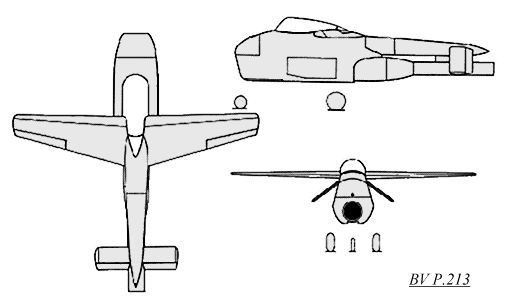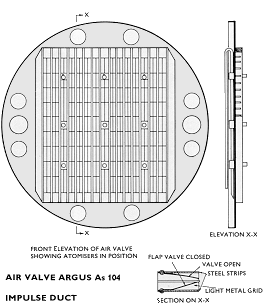 In November 1944, a requirement was issued for a very simple, rapidly produced
small fighter aircraft by the RLM. This Miniaturjäger (Miniature
Fighter) program was to use the simplest and cheapest power plant available,
and to have the minimum of strategic materials and practically no electrical
equipment. The motive power chosen was to be the Argus As 014 pulse jet,
the same power used for the Fi 103 Buzz Bomb (V1), and the Miniaturjäger
was to takeoff and land conventionally. The plan was to be able to build
a large numbers of these aircraft, and thus simply overwhelm the enemy
bomber formations with their numbers. Only three firms participated in
this design competition, Heinkel (with a pulse jet powered He 162 airframe),
Junkers (with their Ju
EF126 project) and Blohm & Voss with the BV P.213.
In November 1944, a requirement was issued for a very simple, rapidly produced
small fighter aircraft by the RLM. This Miniaturjäger (Miniature
Fighter) program was to use the simplest and cheapest power plant available,
and to have the minimum of strategic materials and practically no electrical
equipment. The motive power chosen was to be the Argus As 014 pulse jet,
the same power used for the Fi 103 Buzz Bomb (V1), and the Miniaturjäger
was to takeoff and land conventionally. The plan was to be able to build
a large numbers of these aircraft, and thus simply overwhelm the enemy
bomber formations with their numbers. Only three firms participated in
this design competition, Heinkel (with a pulse jet powered He 162 airframe),
Junkers (with their Ju
EF126 project) and Blohm & Voss with the BV P.213.
The P.213 was to have a simple fuselage, made from armored sheet steel that was preformed in two halves. 420 liters (111 gallons) of fuel was contained in a fuel tank behind the cockpit, which had simple flight controls and no radio or other electronic equipment. Wooden construction was chosen for the shoulder mounted wing, which had a straight leading edge and tapered trailing edge. The tail unit was also made of wood, and angled down sharply. Behind the fuselage was a tail boom, which the Argus As 014 pulse jet was attached to by free-swinging brackets. The front of the pulse jet was also attached to the fuselage's air duct by a rubber mounting. This flexible mounting was designed to minimize the excessive vibrations that the Argus engine produced. To get the pulse jet to operating speed, either a catapult launch or solid booster rockets would be needed. The main gear legs retracted forwards and were supplied with 500 x 180 sized wheels; the nose wheel (size 260 x 85) retracted to the rear and rotated 90 degrees to lie flat beneath the air duct. Because no generator was included in the equipment, a provision for a small compressed air supply was included for retracting the landing gear, a small hand crank was also considered to manually crank up the gear. A single MK 108 30mm cannon was located in the fuselage nose, with the ammunition box (135 rounds) located on top of the MK 108 cannon. Due to the fact that the BV P.213's performance was less than existing Luftwaffe fighters and less than the competing Ju EF126's anticipated performance, the P.213 design was not pursued. In any case, the whole Miniaturjäger (Miniature Fighter) program was canceled a little over one month later, in December 1944.


